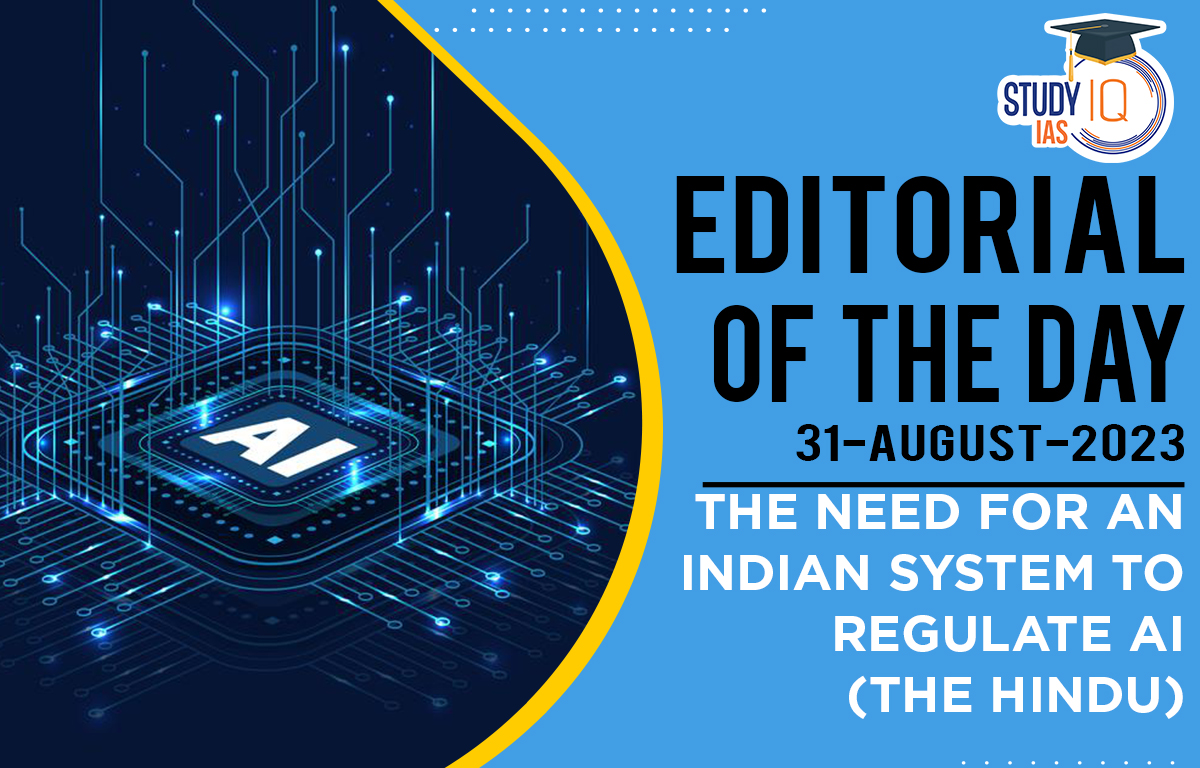Table of Contents
Context: The article is discussing the impact of Artificial Intelligence (AI) on society and the need for its regulation. It highlights the capabilities of AI, such as its potential to reshape the way we work and its ability to generate innovative solutions by analysing vast amounts of online data. The article also acknowledges that AI can have both positive and negative effects. It concludes by suggesting that India should adopt an approach to AI regulation that is influenced by Eastern (oriental) philosophies or strategies implying that India could learn from the regulatory models or principles followed by countries in East Asia.
Background
What is Artificial Intelligence?
- AI is the branch of computer science concerned with developing machines that can complete tasks that typically require human intelligence.
- The goals of artificial intelligence include computer-enhanced learning, reasoning, and perception.
- Artificial intelligence is based on the principle that human intelligence can be defined in a way that a machine can easily mimic it and execute tasks, from the simplest to those that are even more complex.

Global Regulations for AI
| European Union |
|
| India |
|
| United Kingdom |
|
| United States |
|
| China |
|
Decoding the Editorial
- The article makes reference to “oriental and occidental approaches to legal regulation” that alludes to the differing perspectives and methods of regulation between Eastern and Western cultures.
- “Oriental” typically refers to cultures from East Asia, such as countries in the Far East like China, Japan, and Korea.
- “Occidental” refers to cultures from the Western world, such as Europe and the Americas.
- The article suggests that India should adopt an approach to AI regulation that is influenced by Eastern (oriental) philosophies or strategies.
- This may be due to the fact that Eastern countries have been more proactive in certain areas of AI development and regulation, and their cultural values and legal frameworks might offer insights into effectively managing AI’s impact on society.
Western and Eastern approaches:
The article is discussing the differences between Western and Eastern approaches to regulating artificial intelligence (AI) and the underlying philosophies that inform these approaches.
- Regulation of AI in Western Systems:
- The European Union (EU), Brazil, Canada, and the United Kingdom (referred to as “western systems”) have adopted a risk-based approach to AI regulation.
- This involves categorising AI-based applications into different levels of risk and prescribing regulations accordingly.
- These regulations are typically focused on specifying what actions are allowed or prohibited, and they emphasize compliance with clear rules and punishments for violations.
- Regulation of AI in Eastern Models (Japan and China):
- In contrast, the regulation of AI in Japan and China (referred to as “eastern models”) takes a different approach.
- For instance, Japan has established “Social Principles of Human-Human-Centric AI,” emphasising values such as human-centricity, education, data protection, safety, fairness, and innovation.
- Chinese regulations also prioritize adherence to laws, administrative regulations, social morality, and ethics.
- The emphasis in these models is on upholding certain values and achieving specific ends through AI applications, rather than solely focusing on specific rules and punishments.
- Difference in Philosophical Approach:
-
- The article suggests that the difference between the Western and Eastern models stems from deeper philosophical and cultural differences.
- The Western approach is characterized by a clear and explicit set of rules, and the focus is on rule compliance and legal consequences.
- The Eastern approach, on the other hand, is described as more open and interested in the overlap between the legality and morality of rules. This approach is likened to “Hindu Jurisprudence,” which encompasses a broader perspective on law, morality, and ethics.
Theories underlying the Approaches:
The article is discussing the underlying theories and differences between legal systems in Eastern (oriental) and Western (Eurocentric) contexts, particularly in the context of India.
- Creation of Rules of Law in Western Systems: In Western legal systems, rules of law are created through a process of “postulation.” This means that the legal system precisely defines what actions must be taken or prohibited in a given social order. Penalties for non-compliance with these rules are also prescribed. The focus is on the specific actions to be taken and the corresponding consequences.
- Creation of Rules of Law in Eastern Systems: In Eastern or oriental legal systems, rules of law are created through a process of “intuition.” Here, the law outlines the desired end or goal that should be achieved, along with the underlying moral code. People are expected to intuitively determine the most appropriate means to achieve these ends, considering the moral framework of the law. The emphasis is on achieving the intended outcome while adhering to the moral principles.
- Success of Ancient Indian Legal Systems: The article mentions that ancient Indian legal systems were successful because they had clear goals or ends to be achieved, as well as a strong underlying moral code. People followed these laws by intuitively understanding the appropriate actions based on moral values. The Pandavas’ exile to the forest and Emperor Ashoka’s edicts are cited as examples of this approach.
- Synonymous Nature of Law and Morality in the East: The article highlights that in Eastern legal systems, particularly in neighbouring China, law and morality are treated as synonymous. Legal rules are deeply intertwined with moral values and principles, reflecting a holistic approach to law.
- Impact of British Colonialism: The British colonization of India resulted in the transplantation of the British legal system, which is neither aligned with the virtues of the ancient Indian legal system nor fully with the virtues of the English legal system. The article suggests that the legal system in India today lacks the benefits of both historical Indian legal principles and those of the British system.
Approach India must take for AI Regulation:
- Lamenting the Slavish Tendency to Imitate Western Systems: Justice V. Ramasubramaniam, a retired judge of the Supreme Court of India, has expressed concern about India’s tendency to blindly copy Western legal systems. He emphasizes the need for India to develop its own approach to legal matters, rather than simply imitating the West.
- Sanskit Epigram “Neti Neti”: One of Justice Ramasubramaniam’s notable judgments on cryptocurrency in India incorporated the Sanskrit epigram “neti neti,” which translates to “it is neither this nor that.” This alludes to the idea of looking beyond apparent similarities and questioning whether India should replicate Western regulations without considering its unique context.
- NITI Aayog’s Discussion Papers: NITI Aayog, a policy think tank of the Indian government, has circulated discussion papers related to AI regulations. These papers refer to AI regulations in countries such as the EU, the United States, Canada, the United Kingdom, and Australia. The implication is that NITI Aayog might be leaning towards adopting a Western model for AI regulation.
- Importance of Consistency with Indian Ethos: The article argues that it is crucial for India to develop AI regulations that align with Indian cultural and philosophical values. It suggests that the regulations should be in line with the Indian ethos and cater to the needs and aspirations of the Indian population.
- Advocating an Eastern Approach: The conclusion drawn from the article is that India should not blindly follow the Western model of AI regulation. Instead, it should draw inspiration from its own cultural heritage and legal philosophy, possibly embracing an Eastern approach that considers values, ethics, and holistic perspectives.
Beyond the Editorial
AI Laws in India
- India does not have any specific law regarding application of AI.
- The Ministry of Electronics and Information Technology (MeitY) is the regulatory body of AI in India.
- It has the responsibility development, implementation and management of AI laws and guidelines in India.
- There are certain provisions mentioned under Intellectual Property Law and several provisions as Section 43A & 72A of Information Technology Act, 2000 which implies that if anyone commits crime by using AI, then he will be liable under IT Act, criminal law and other cyber law.
- Information Technology (Intermediary Guidelines and Digital Media Ethics Code) Rules 2021 obligates the social media platforms to exercise greater diligence regarding content on their platforms.
- In 2018, the planning commission of India came up with the National Strategy on Artificial Intelligence (NSAI) considering setting up a panel consisting ministry of corporate affairs & the department of Industrial policy 7 promotion to look over the regulation.
- Niti Aayog also worked towards the establishment of AIRAWAT– AI Research, Analytics and knowledge Assimilation platform. AIRAWAT considers the requirements for better use of AI.
- In 2020, Niti Aayog drafted documents based on launching an oversight body and enforcement of responsible AI principles (Safety & rehabilitee, equality, inclusivity, non-discrimination, privacy & security, transparency, accountability, protection & reinforcement of human values) for Inspection of principles, formation of legal and technical work, creation of new techniques and tools of AI and representation of India at Global standard.


 Daily Quiz 01 July 2025
Daily Quiz 01 July 2025
 China, Pakistan and Bangladesh Trilatera...
China, Pakistan and Bangladesh Trilatera...
 US Pulls Funding from GAVI-Global Vaccin...
US Pulls Funding from GAVI-Global Vaccin...





















